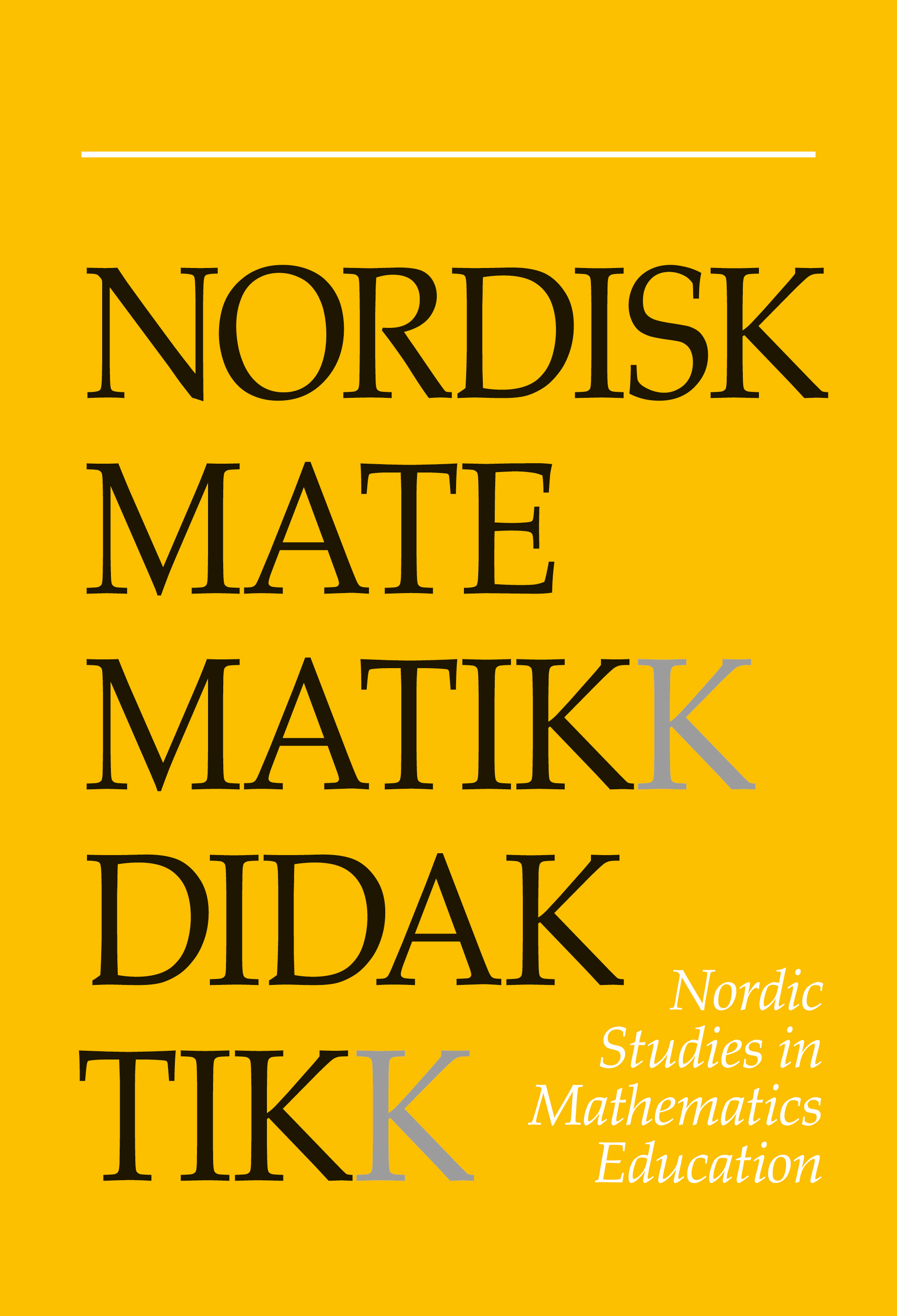Et miljø for algebraisk generalisering og dets innvirkning på studenters matematiske aktivitet
DOI:
https://doi.org/10.7146/nomad.v22i2.148874Abstract
Denne artikkelen handler om hvordan egenskaper ved en didaktisk situasjon i matematikk påvirker studenters muligheter til å løse en algebraisk generaliseringsoppgave. Studien er gjennomført innenfor et lærerutdanningsprogram ved en høgskole, og datamaterialet består av matematikkoppgaven og et videoopptak av tre studenters samarbeid for å løse oppgaven. Transkripsjonen av videoopptaket er analysert ved den konstant komparative metoden, der teorien for didaktiske situasjoner i matematikk (TDS) er brukt for å forstå hvilke egenskaper ved den didaktiske situasjonen som begrenser studentenes muligheter for å løse oppgaven. Den observerte didaktiske situasjonen er en ordinær undervisningssituasjon i den forstand at den ikke er et resultat av didaktisk ingeniørvirksomhet basert på TDS. Resultatene fra analysen viser hvordan to faktorer skaper avstand mellom lærerens hensikt med den gitte matematikkoppgaven og studentenes aktivitet knyttet til oppgaven. Den ene faktoren handler om begrepet ”matematisk setning” som studentene tillegger en annen betydning enn den læreren legger til grunn; den andre faktoren handler om lærerens bruk av et generisk eksempel uten at de generelle egenskapene til eksemplet blir diskutert. Studien bidrar til innsikt i sammenhengen mellom et miljø for en adidaktisk situasjon og den matematikkunnskapen som studenter har mulighet for å utvikle i det aktuelle miljøet.
References
Artigue, M., Haspekian, M. & Corblin-Lenfant, A. (2014). Introduction to the theory of didactical situations (TDS). I A. Bikner-Ahsbahs & S. Prediger (Red.), Networking of theories as a research practice in mathematics education (s. 47-65). Cham: Springer. https://doi.org/10.1007/978-3-319-05389-9_4
Bachelard, G. (2001). The formation of the scientific mind: a contribution to a psychoanalysis of objective knowledge (M. M. Jones, Overs.). Manchester: Clinamen Press. (Originalt arbeid publisert i 1938)
Bosch, M., Chevallard, Y. & Gascón, J. (2006). Science or magic? The use of models and theories in didactics of mathematics. I M. Bosch (Red.), Proceedings of the fourth Congress of the European Society for Research in Mathematics Education (s. 1254-1263). Barcelona: Universitat Ramon Llull Editions.
Brousseau, G. (1997). The theory of didactical situations in mathematics: didactique des mathématiques. Dordrecht: Kluwer.
Chevallard, Y. (1989). On didactic transposition theory: some introductory notes. I H. G. Steiner & M. Hejny (Red.), Proceedings of the International Symposium on Selected Domains of Research and Development in Mathematics Education (s. 51-62). University of Bratislava. Hentet fra http://yves.chevallard.free.fr/spip/spip/article.php3?id_article=122
Corbin, J. & Strauss, A. (2008). Basics of qualitative research: techniques and procedures for developing grounded theory (3. utg.). Thousand Oaks: Sage. https://doi.org/10.4135/9781452230153
Grønmo, L. S., Onstad, T., Nilsen, T., Hole, A., Aslaksen, H. & Borge, I. C. (2012). Framgang, men langt fram. Oslo: Akademika Forlag.
Herscovics, N. & Linchevski, L. (1994). A cognitive gap between arithmetic and algebra. Educational Studies in Mathematics, 27, 59-78. https://doi.org/10.1007/BF01284528
Katz, V. (2007). Algebra: a gateway to a technological future. Washington: The Mathematical Association of America.
Kendal, M. & Stacey, K. (2004). Algebra: a world of difference. I K. Stacey, H. Chick & M. Kendal (Red.), The future of the teaching and learning of algebra: the 12th ICMI study (s. 329-346). Dordrecht: Kluwer. https://doi.org/10.1007/1-4020-8131-6_13
Kieran, C. (1992). The learning and teaching of school algebra. I D. Grouws (Red.), Handbook of research on teaching and learning (s. 390-419). New York: Macmillan.
Kieran, C. (2004). The core of algebra: Reflections on its main activities. I K. Stacey, H. Chick & M. Kendal (Red.), The future of the teaching and learning of algebra: the 12th ICMI study (s. 21-33). Dordrecht: Kluwer. https://doi.org/10.1007/1-4020-8131-6_2
Kieran, C. (2007). Learning and teaching algebra at the middle school through college levels: building meaning for symbols and their manipulation. I F. Lester (Red.), Second handbook of research on mathematics teaching and learning (s. 707-762). Charlotte: Information Age Publishing.
Kjærnsli, M. & Olsen, R. V. (Red.). (2013). Fortsatt en vei å gå: Norske elevers kompetanse i matematikk, naturfag og lesing i PISA 2012. Oslo: Universitetsforlaget.
Küchemann, D. (1981). Algebra. I K. M. Hart (Red.), Children's understanding of mathematics: 11-16 (s. 102-119). London: John Murray.
Laborde, C. & Perrin-Glorian, M.-J. (2005). Introduction. I C. Laborde, M.-J. Perrin-Glorian & A. Sierpinska (Red.), Beyond the apparent banality of the mathematics classroom (s. 1-12). Dordrecht: Springer. https://doi.org/10.1007/0-387-30451-7
MacGregor, M. & Stacey, K. (1997). Students' understanding of algebraic notation: 11-15. Educational Studies in Mathematics, 33, 1-19. https://doi.org/10.1023/A:1002970913563
Mason, J. & Pimm, D. (1984). Generic examples: seeing the general in the particular. Educational Studies in Mathematics, 15, 277-289. https://doi.org/10.1007/BF00312078
Moss, J. & Beatty, R. (2006). Knowledge building in mathematics: supporting collaborative learning in pattern problems. Computer-Supported Collaborative Learning, 1, 441-465. https://doi.org/10.1007/s11412-006-9003-z
Noss, R., Healy, L. & Hoyles, C. (1997). The construction of mathematical meanings: connecting the visual with the symbolic. Educational Studies in Mathematics, 33, 203-233. https://doi.org/10.1023/A:1002943821419
OECD. (2013). PISA 2012 results: what students know and can do - student performance in mathematics, reading and science (Volume I). Paris: Forfatteren.
Rowland, T. (2000). The pragmatics of mathematics education: vagueness in mathematical discourse. London: Falmer Press.
Sierpinska, A. (1999). Discovery teaching/learning and the theory of didactic situations (TDS-lecture 8). Hentet fra http://annasierpinska.rowebca.name/pdf/TDSLecture%208.pdf
Stacey, K., Chick, H. & Kendal, M. (Red.). (2004). The future of the teaching and learning of algebra: the 12th ICMI study. Dordrecht: Kluwer. https://doi.org/10.1007/1-4020-8131-6
Strømskag Måsøval, H. (2011). Factors constraining students' appropriation of algebraic generality in shape patterns: a case study of didactical situations in mathematics at a university college (Doktoravhandling). Universitetet i Agder.
Utdanningsdirektoratet. (2013). Læreplan i matematikk fellesfag. Hentet fra http://www.udir.no/kl06/MAT1-04/Hele/Grunnleggende_ferdigheter/ Warfield, V. M. (2007). Invitation to didactique. Bloomington: Xlibris.
Watson, A. (2009). Paper 6: algebraic reasoning. I T. Nunez, P. Bryant & A. Watson (Red.), Key understandings in mathematics learning: a report to the Nuffield Foundation. Hentet fra http://www.nuffieldfoundation.org/key-understandings-mathematics-learning
Whitehead, A. N. (1947). Essays in science and philosophy. New York: Philosophical Library.
Winsløw, C. (2006). Didaktiske elementer: en indføring i matematikkens og naturfagenes didaktik. Frederiksberg: Biofolia.
Downloads
Published
How to Cite
Issue
Section
License

This work is licensed under a Creative Commons Attribution-NonCommercial-ShareAlike 4.0 International License.



